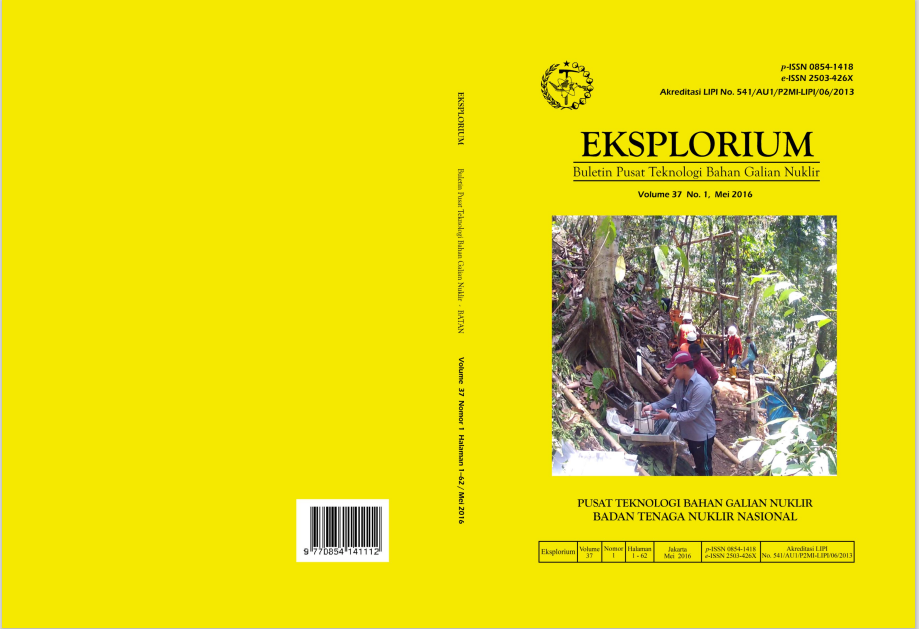Identifikasi Akuifer Dangkal di Pulau Terdepan NKRI dengan Menggunakan Metode Geolistrik 2D: Studi Kasus Pulau Laut, Kab. Natuna
Main Article Content
Abstract
The need for fresh water to support community activities in the field of fisheries on the frontier island is necessary because this location has minimal condition to the source of fresh water. Geophysical research with 2D geoelectrical methods conducted to identify the aquifers in the area of Pulau Laut, Natuna Regency as the frontier island of United Country of Republic Indonesia (NKRI). In field, measurement is using six 2D geoelectric lines with Wenner configuration and 160 m cable stretching to obtain 26.9 m sub-surface depth penetration. Resistivity data in Pulau Laut used to identify the aquifer presence in research area. Aquifers are located on varies depth near the surface with a depth of 2.5 – 13 m in north line, PDAM line, and Air Paying line; 12 – 26.9 m in Kadur line, Air Bunga line, and Air Paying line. Resistivity value for each aquifer varies for each line. They are ranging from 0.651 – 14 Ωm. Lithologies, composing the aquifer, are sandstone unit in Kadur, Air Bunga, Talaga Tasik, and Air Paying lines; silstone in PDAM line; and limestone in the north line.
Article Details

This work is licensed under a Creative Commons Attribution-ShareAlike 4.0 International License.
1. Introduction
By using or sharing content from EKSPLORIUM - Buletin Pusat Pengembangan Bahan Galian Nuklir ("the Journal"), you agree to follow these Terms and Conditions. The Journal's content is licensed under the Creative Commons Attribution-NonCommercial-ShareAlike (CC BY-NC-SA) license. If you do not agree to these terms, please do not use the content.
2. How You Can Use the Content
-
Share: You can copy, share, and distribute the work, but only for non-commercial purposes.
-
Adapt: You can change, remix, or build on the work, as long as it is for non-commercial purposes and you share it under the same license (CC BY-NC-SA).
3. Attribution (Giving Credit)
When you use or share the content, you must:
-
Give proper credit to the author(s).
-
Mention the title of the work and the journal name.
-
Provide a link to the license (https://creativecommons.org/licenses/by-nc-sa/4.0/).
-
Indicate if you made any changes to the work.
4. Non-Commercial Use
You cannot use the work to make money or for any commercial activities. For example, you cannot sell or use the content in advertisements.
If you want to use the content for commercial purposes, you need to get permission from the author(s) or the publisher.
5. ShareAlike
If you make changes to the content (like creating a new version or remixing it), you must share your new version under the same CC BY-NC-SA license.
6. Exclusions
Some materials in the Journal may have different licenses or restrictions, such as third-party content (like images or datasets). You must respect the rules for those materials.
7. No Warranty
The content is provided "as is." The authors and publisher do not guarantee that the content is error-free or suitable for any specific purpose. Use the content at your own risk.
8. Modifications and Withdrawal of Content
The publisher and authors can update or remove content at any time. If content is removed, the previous versions will still follow these terms.
9. Ethical Use
You must use the content ethically and follow all relevant laws. This includes properly citing the original authors and not misusing the content.
10. Legal Compliance
You are responsible for making sure your use of the content follows the laws of your country. If you believe content violates your rights, please contact us.
11. Changes to Terms
These Terms and Conditions may be updated from time to time. Any changes will be posted on the Journal's website.
12. Contact Information
For questions about these Terms or for permission to use content commercially, please contact us at:
-
Email: eksplorium@brin.go.id
-
Website: https://ejournal.brin.go.id/eksplorium
Conclusion
By using the content from EKSPLORIUM - Buletin Pusat Pengembangan Bahan Galian Nuklir, you agree to follow these Terms and Conditions and the CC BY-NC-SA 4.0 International License.
References
R. Indonesia, Peraturan Pemerintah Nomor 62 tentang Pemanfaatan Pulau-pulau Kecil Terluar. Indonesia, 2010.
Delinom dan M. Robert, “Sumber Daya Air di Wilayah Pesisir dan Pulau-pulau Kecil,” Jakarta, 2007.
A. S. Hakim dan N. Suryono, Peta Geologi Lembar Teluk Butun dan Ranai, Sumatra. Bandung: Pusat Penelitian dan Pengembangan Geologi, 1994.
B. Kab.Natuna, “Statistik Daerah Kecamatan Pulau Laut,” Natuna, 2015.
USGS, “Citra Satelit Landsat 7 ETM,” 2013. [Online]. Available: http://landsat.usgs.gov/landsat7.php. [Accessed: 04-Oct-2015].
A. Herlambang, “Kualitas Air Tanah Dangkal di Kabupaten Bekasi,” IPB, 1996.
R. J. Kodoatie, Pengantar Hidrogeologi. Yogyakarta: Andi Offset, 1996.
G. P. Kruseman and N. A. De Ridder, Analysis and Evaluation of Pumping Test Data, 2nd ed. Wageningen: International Institute for Land Reclamation and Improvement, Wageningen, 1994.
A. S. Wijaya, “Aplikasi Metode Geolistrik Resistivitas Konfigurasi Wenner untuk Menentukan Struktur Tanah di Halaman Belakang SCC ITS Surabaya,” J. Fis. Indones., vol. 19, no. 55, pp. 1–5, 2015.
M. Hasanudin dan D. G. Pryambodo, “Studi Intrusi Air Laut di Cirebon dengan Menggunakan Metode Geolistrik,” J. Segara, vol. 5, no. 2, pp. 121–133, 2009.
D. Santoso, Pengantar Teknik Geofisika. Bandung: Departemen Teknik Geofisika ITB, 2002.
GARMIN, “GPSMAP 78 Series Manual,” 2010. [Online]. Available: http://gpscentrs.lv/instrukcijas/GPSMAP_78_OM_EN.pdf. [Accessed: 06-Nov-2015].
GEOCIS, “S Field Resistivity Automatic Multichannel (16 CH),” 2015. [Online]. Available: http://www.geocis.net/file-download/S-FIELD-.pdf. [Accessed: 06-Nov-2015].
W. M. Telford, L. P. Geldart, and R. E. Sheriff, Applied Geophysics, 2nd ed. New York: Cambridge University Press, 1990.
M. H. Loke, Tutorial 2D and 3D Electrical Imaging Surveys. Birmingham: Birmingham University, 2004.
G. J. Palacky, “Resistivity Characteristics of Geologic Targets,” in Electromagnetic Methods in Applied Geophysics Theory, Vol. 1, Okla: Society of Exploration Geophysicists, 1987.
S. Mandel and Z. L. Shiftan, Groundwater Resources : Investigation and Development. London: Academic Press, 1981.

